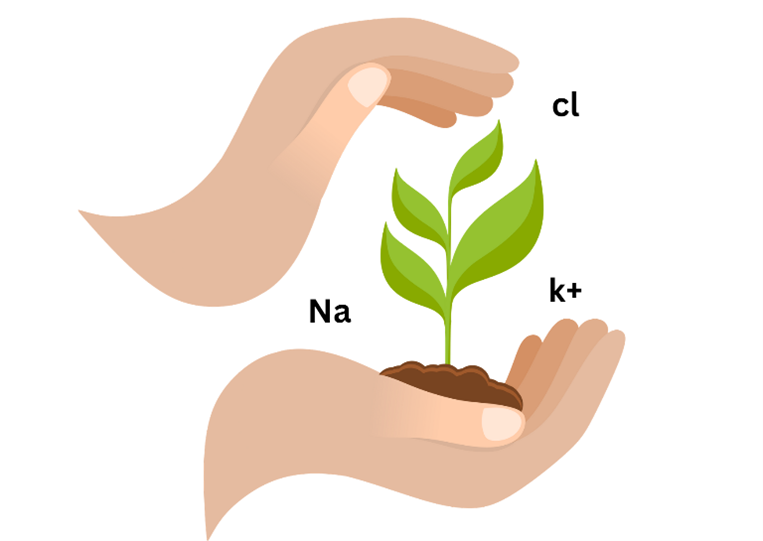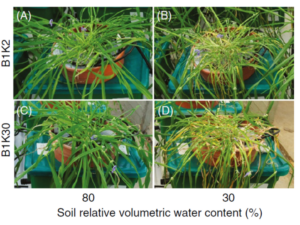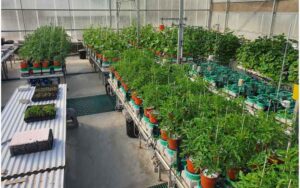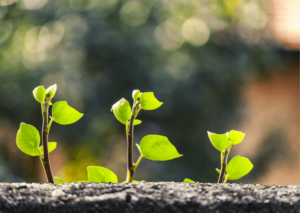In an era where global food security faces unprecedented challenges from climate change and land degradation, the development and identification of salt tolerant crop varieties has become a critical priority for agricultural sustainability. As soil salinity affects approximately 20% of the world’s cultivated land and 33% of irrigated agricultural lands, the need for salt tolerant crop solutions has never been more urgent.
These resilient plant varieties represent a key strategy in maintaining agricultural productivity in regions where conventional crops struggle to survive, offering hope for farmers dealing with increasing salinity levels worldwide. Understanding the mechanisms behind salt tolerance and implementing advanced technologies to identify and develop salt tolerant crop varieties is essential for feeding the growing global population while adapting to environmental challenges.
What is Salinity and How Does it Form?
Understanding Salt in Agricultural Context
Salinity refers to the accumulation of dissolved salts, primarily sodium chloride (NaCl), in soil or water at levels that impair plant growth. In agricultural settings, salinity develops through both natural processes and human activities. Natural salinity occurs in arid regions where evaporation exceeds precipitation, concentrating salts in the upper soil layers. Human-induced salinity often results from irrigation practices, where water evaporates leaving salts behind, or from rising water tables bringing dissolved salts to the root zone.
The Formation Process
[Diagram: Salinity Formation Cycle]
┌─────────────────────────────────────┐
│ SALINITY FORMATION │
├─────────────────────────────────────┤
│ Irrigation Water → Evaporation │
│ ↓ │
│ Salt Accumulation in Soil │
│ ↓ │
│ Rising Water Table │
│ ↓ │
│ Root Zone Salinization │
└─────────────────────────────────────┘
The concentration of salts increases through capillary action, where water moves upward through soil pores and evaporates at the surface, leaving salt deposits. Climate change intensifies this process through increased temperatures and altered precipitation patterns, making the development of salt tolerant crop varieties increasingly important.
How Does Salinity Affect Plants and Yield?
Primary Stress Mechanisms
Salinity affects plants through two primary mechanisms: osmotic stress and ionic toxicity. Osmotic stress occurs when high salt concentrations in soil reduce water availability to plants, even when soil moisture appears adequate. This forces plants to expend more energy to extract water, reducing growth and yield. For salt tolerant crop varieties, specialized mechanisms help maintain water uptake despite these challenging conditions.
Ionic Toxicity Impact
[Diagram: Salt Stress Effects on Plants]
┌────────────────────────────────────────┐
│ SALT STRESS ON PLANTS │
├────────────────────────────────────────┤
│ High Na+ & Cl- → Cell Membrane Damage│
│ ↓ │
│ Nutrient Imbalance (K+, Ca2+, Mg2+) │
│ ↓ │
│ Reduced Photosynthesis │
│ ↓ │
│ Decreased Growth & Yield │
└────────────────────────────────────────┘
When sodium and chloride ions accumulate in plant tissues, they disrupt cellular processes, damage membranes, and interfere with enzyme activities. This ionic toxicity particularly affects photosynthesis, reducing the plant’s ability to produce energy and biomass.
Yield Reduction Patterns
Studies show that salinity can reduce crop yields by 20-50% in moderately saline soils and up to 100% in severely affected areas. The development of salt tolerant crop varieties can significantly mitigate these losses, maintaining productivity where traditional varieties fail. Early growth stages, particularly germination and seedling establishment, are most vulnerable to salt stress, making early-stage tolerance a key trait in successful salt tolerant crop development.
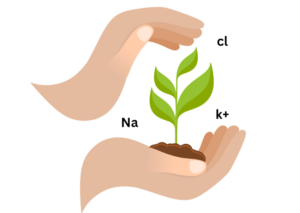
How Do Plants Adapt to Saline Conditions?
Ion Exclusion and Regulation
Salt tolerant crop varieties employ sophisticated ion exclusion mechanisms at the root level. Specialized proteins in root cell membranes act as gatekeepers, preventing excessive sodium uptake while maintaining essential nutrient absorption. These plants can selectively absorb potassium over sodium, maintaining favorable K+/Na+ ratios critical for cellular function.
Compartmentalization Strategies
[Diagram: Cellular Salt Compartmentalization]
┌─────────────────────────────────────┐
│ SALT COMPARTMENTALIZATION │
├─────────────────────────────────────┤
│ Cytoplasm (Low Na+) │
│ ↓ │
│ Active Transport │
│ ↓ │
│ Vacuole (High Na+ Storage) │
│ │
│ Result: Protected Cell Function │
└─────────────────────────────────────┘
Advanced salt tolerant crop varieties sequester toxic ions in vacuoles, protecting sensitive cellular machinery in the cytoplasm. This compartmentalization allows plants to tolerate higher salt levels without compromising metabolic processes.
Osmotic Adjustment
Plants synthesize compatible solutes like proline, glycine betaine, and sugars to maintain cellular water balance. These organic compounds don’t interfere with cellular processes while helping cells retain water under saline conditions. Salt tolerant crop varieties often show enhanced production of these protective compounds.
Antioxidant Defense Systems
Salt stress generates harmful reactive oxygen species (ROS) that damage cellular components. Successful salt tolerant crop varieties possess enhanced antioxidant systems, including enzymes like superoxide dismutase, catalase, and peroxidase, which neutralize these harmful molecules and protect cellular integrity.
What are the agricultural Importance and Technological Solutions?
Economic Impact
The economic importance of developing salt tolerant crop varieties cannot be overstated. With salinity causing annual agricultural losses exceeding $27 billion globally, investing in salt-resistant varieties offers substantial returns. These varieties enable cultivation in marginal lands, expanding agricultural frontiers and supporting food security.
Breeding Innovations
Modern breeding programs combine traditional selection with molecular markers to accelerate salt tolerant crop development. Marker-assisted selection identifies genes associated with salt tolerance, reducing breeding cycles from 10-15 years to 5-7 years. Genetic engineering introduces salt tolerance genes from halophytes into crop species, creating novel salt tolerant crop varieties with enhanced resistance.
Precision Agriculture Integration
[Diagram: Integrated Salt Management System]
┌────────────────────────────────────────┐
│ PRECISION SALT MANAGEMENT │
├────────────────────────────────────────┤
│ Soil Salinity Mapping │
│ ↓ │
│ Variety Selection │
│ ↓ │
│ Targeted Irrigation │
│ ↓ │
│ Real-time Monitoring │
│ ↓ │
│ Optimized Yield │
└────────────────────────────────────────┘
Advanced Monitoring Technology: What is the PlantArray System Advantage?
Why PlantArray Excels Over Conventional Methods?
The PlantArray system revolutionizes salt tolerant crop research by providing continuous, non-invasive monitoring that surpasses traditional assessment methods. Unlike conventional approaches requiring destructive sampling and providing only snapshot data, PlantArray delivers real-time physiological measurements throughout the plant’s lifecycle. This dynamic monitoring captures stress responses as they occur, enabling researchers to identify the optimal salt tolerant crop varieties with unprecedented precision.
How does PlantArray speed up the research timeline?
Traditional breeding programs require multiple growing seasons to evaluate salt tolerance, often taking 3-5 years for reliable results. PlantArray compresses this timeline to mere weeks, providing comprehensive data on water relations, growth rates, and stress responses under controlled salinity conditions. This acceleration means that a salt tolerant crop variety that might have taken years to validate can now be confirmed in a single experimental run.
What makes PlantArray’s data quality superior?
The system simultaneously measures multiple physiological parameters including transpiration, biomass accumulation, water use efficiency, and root activity. This integrated approach provides a holistic view of plant performance impossible to achieve with conventional methods. Researchers can correlate responses across different parameters, identifying subtle tolerance mechanisms that might be missed by traditional screening methods.
Practical Field Applications
Water and Resource Conservation
Implementing salt tolerant crop varieties identified through advanced screening significantly reduces water requirements. These varieties maintain productivity with 20-30% less irrigation water, as they efficiently utilize available moisture even under saline conditions. This conservation extends to fertilizer use, as salt-adapted plants show improved nutrient uptake efficiency, reducing input costs and environmental impact.
Preventing Yield Losses in Saline Areas
Field trials demonstrate that properly selected salt tolerant crop varieties can maintain 70-85% of normal yields in moderately saline soils where conventional varieties produce only 40-50%. This yield stability translates directly to improved farmer income and food security in affected regions. The PlantArray system’s precise characterization ensures that the selected varieties perform consistently under field conditions.
Supporting Optimal Variety Selection for Problem Areas
The detailed physiological profiles generated by PlantArray enable precise matching of salt tolerant crop varieties to specific field conditions. Rather than broad recommendations, farmers receive targeted variety suggestions based on their soil salinity levels, water quality, and climate conditions. This precision selection maximizes success rates and return on investment.
Economic Benefits
Farmers adopting PlantArray-validated salt tolerant crop varieties report average income increases of 35-45% in saline-affected areas. The technology enables cultivation of previously abandoned lands, expanding productive agricultural area without clearing new land. This sustainable intensification supports both economic development and environmental conservation.
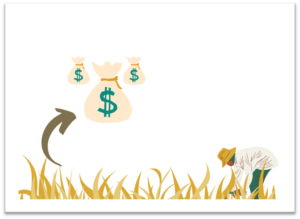
What is the Marketing Value and Implementation Strategy?
Comprehensive Solution Package
The PlantArray system offers a complete solution for salt tolerance research and variety development. From initial screening to field validation, the technology provides actionable data that accelerates breeding programs and ensures reliable variety performance. This comprehensive approach reduces research risks and increases the probability of developing successful salt tolerant crop varieties.
What is the return on Investment?
Organizations using PlantArray report research cost reductions of 40-60% compared to traditional methods. The rapid screening capability allows evaluation of 10 times more genetic material in the same timeframe, dramatically increasing the chances of identifying superior salt tolerant crop varieties. This efficiency translates to faster market introduction and competitive advantage.
Does this technology have global potential?
With salinity affecting agricultural regions worldwide, salt tolerant crop solutions developed using PlantArray have global market potential. The technology’s versatility allows adaptation to different crops and salinity levels, making it valuable for diverse agricultural systems from intensive irrigated agriculture to subsistence farming in marginal lands.
Why is This Cutting-Edge Technology Essential for the Future?
The development and deployment of salt tolerant crop varieties by Plant-Ditech represents a critical strategy for maintaining agricultural productivity in an era of increasing environmental challenges. Advanced technologies like the PlantArray system accelerate this development, providing precise, real time data that enables rapid identification of superior varieties.
By combining cutting edge monitoring technology with traditional breeding and modern genetic approaches, we can develop salt tolerant crop solutions that ensure food security while conserving precious water and land resources. The future of agriculture in saline affected regions depends on our ability to identify, develop and deploy these resilient varieties, making investment in advanced screening technologies not just beneficial but essential for sustainable agricultural development.
How can I get a PlantArray system?
Contact us using the tab on the side of the page or through the ‘Contact Us‘ page and we will get back to you soon with all the details.
References
- Munns, R., & Gilliham, M. (2015). Salinity tolerance of crops – what is the cost? New Phytologist, 208(3), 668-673.
- Qadir, M., Quillérou, E., Nangia, V., et al. (2014). Economics of salt-induced land degradation and restoration. Natural Resources Forum, 38(4), 282-295.
- Roy, S. J., Negrão, S., & Tester, M. (2014). Salt resistant crop plants. Current Opinion in Biotechnology, 26, 115-124.
- Shabala, S., & Munns, R. (2017). Salinity stress: physiological constraints and adaptive mechanisms. In Plant Stress Physiology (pp. 24-63). CAB International.
- Ismail, A. M., & Horie, T. (2017). Genomics, physiology, and molecular breeding approaches for improving salt tolerance. Annual Review of Plant Biology, 68, 405-434.
- Morton, M. J., Awlia, M., Al-Tamimi, N., et al. (2019). Salt stress under the scalpel – dissecting the genetics of salt tolerance. The Plant Journal, 97(1), 148-163.
- Zörb, C., Geilfus, C. M., & Dietz, K. J. (2019). Salinity and crop yield. Plant Biology, 21, 31-38.
- Van Zelm, E., Zhang, Y., & Testerink, C. (2020). Salt tolerance mechanisms of plants. Annual Review of Plant Biology, 71, 403-433.

